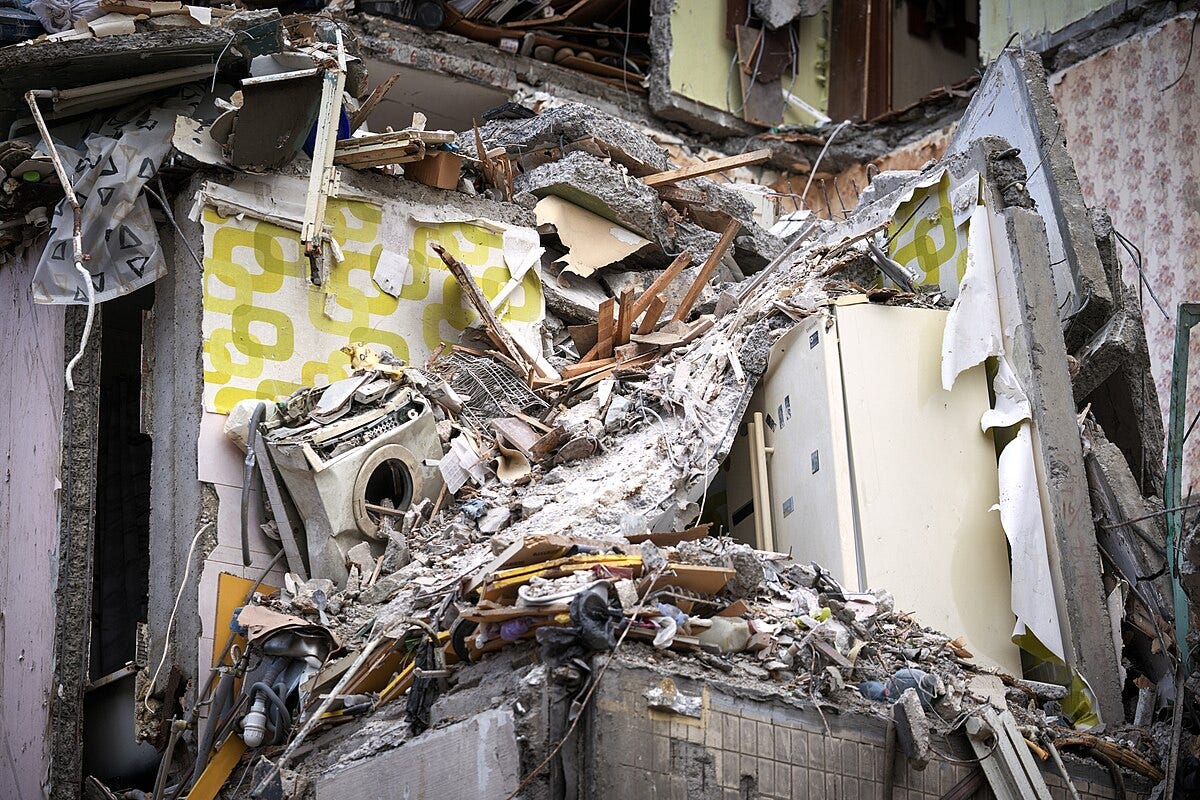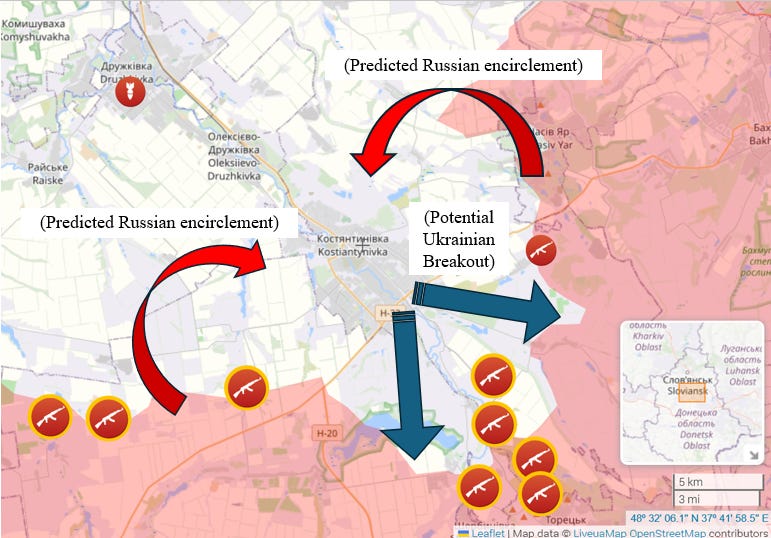The Fall of a Crystal Palace
The New Shape for the War in Ukraine
Nikolay Chernyshevsky, the renowned Russian writer and leader of the Nihilists, wrote of the economy of the future as a “crystal palace.” Chernyshevsky’s crystal palace is an autonomous structure of cast iron and glass, where all the dirty work is done by robots. The only duty of civilians in the crystal palace is to enjoy themselves and reap the fruits of the machine in which they live. Vladimir Putin’s war economy (and indeed all of Russia) is a crystal palace, and it is on the brink of total implosion.
As of mid-September, Putin has accepted that the war will not be won over three days. It will not even be won over three years. Rather, this war is one of attrition. The path to a Russian victory is pure stamina: to chip away at Ukraine’s defenses and bombard their territory such that the state will seize up and eventually collapse from within. To this end, the Russian economy has been re-arranged to prolong this war from a three-day sprint into a long-distance marathon. It’s not a clash of pure strategy or innovative tactics, but a competition between two defense-industrial bases.
For their part, Ukraine has adapted to this new reality by bolstering air defense from the ground up. I was recently privileged to hear a conversation with Maj. Gen. Keith Phillips, recently the defense attaché of the U.S. office in Ukraine. “[It’s an] absolutely remarkable story,” Phillips said. “[They had] zero control of the airspace in 2022, essentially. And now, despite significant kinetic activity almost every single evening [and] records being broken overnight, they’re doing a pretty remarkable job.”
Inside and Outside the Crystal Palace
In persuading Russian citizens to acquiesce to this state of permanent war, the Russian state is offering distractions like the Summer in Moscow festival, which turned the capital into a carnival with “fourteen open-air theaters, one of them floating on water… opera, drama and even clowns riding unicycles.” The citizens of the crystal palace are receiving these entertainments in exchange for their continued participation in the new Russian war economy, in which drone and munitions output are the new goals.
As Putin attempts to convince the Russian people to accept their state’s authority, he also attempts to convince the Ukrainian people to reject theirs. While Putin attended the 2025 China Victory Day Parade, his military unleashed a major barrage against civilian areas in Ukraine. Demoralization and perceived isolation is the express goal. While Russia is ringed with friends, Putin argues, Ukraine stands alone under fire.
But this is not the case, as his own military strategy betrays. The massive drone incursion over Poland, Iranian-produced drones violating Romanian airspace, and the Russian fighter jets which spent twelve minutes in Estonian airspace represent a NATO-targeted adaptation of this attrition strategy. The increasing severity of these incidents, all of them within a week, forces us to conclude that NATO is being intimidated. Putin’s flagrant violations argue: “Russia wants this conflict, and can handle it.” NATO loses when it accepts this false narrative.
Most agree that NATO would trounce Russia in a head-to-head clash. The airspace violations are a way of testing the West’s appetite. If we only respond to this stress-test with statements of concern and consternation, and Article-IV consultation, we will essentially be handing Putin a writ of approval to continue his war-of-attrition strategy, unheeded. Action is required. However, it need not take the form of direct engagement with Russia. I use the rest of this brief to discuss the options that action could take.
Decisions, Decisions
This moment represents an opportunity to simultaneously bolster Ukraine’s defenses and test fresh tactics which would greatly strengthen NATO’s own posture.
Option One: Supply-by-Drone for a Shrunken Force
The first option is a massive increase in the strength and numbers of supply-delivering drones. This would solve a few key problems on the battlefield. Clayton Simms, a former Marine and volunteer on the front lines, notes that while the war has been in a stall, its scale has also shrunk. Units are now smaller, achieving the same or better results as large groups; most of these units are under constant siege from drones and fighting on two or three hours of sleep per night, or lower. As drone warfare becomes the new normal, the gear required to prosecute said war balloons: most of these exhausted soldiers are carrying between seventy-five and one hundred pounds of material at any given time. These units are on a fundamental level haggard and exhausted, but are effectively holding territory with a deep sense of resolve.
In the status quo, small groups, a handful of exhausted men each, are being inconsistently resupplied by deeply exposed convoys. It needn’t be this way. We should be running constant, small-scale drone-delivery of critical materials (shelf-stable food, cases of ammunition, and medical supplies). This would serve as a major force multiplier and reserve large vehicles for extracting units from the field whenever rotations become possible. The West, from Raytheon to Rheinmetall, should be mass-producing these supply drones, and they should include livestreaming and archival capabilities with integrated algorithmic review. Every time a drone is downed, the AI should review the footage and identify what went wrong. Eventually, they will become unbeatable. The best time to develop a human-in-the-loop machine learning system for flying drones was yesterday. The second-best time is today.
Option Two: A Directed Energy Solution for Enemy Drones
Likewise, the shape for counter-drone tactics could benefit from serious revisioning. Simms notes that Ukrainian soldiers now carry shotguns in addition to the rest of their arsenal, specifically to target and take down drones. It needn't be this way. America can (and should) eat the cost of the new counter drone lasers produced by Electro Optic Systems. They “can shoot down 20 drones a minute, at a cost of less than 10 cents per shot.”
All signs point to directed energy playing a critical role in Trump’s Golden Dome project. This is the perfect moment to test out a top contender in the industry. If E.O.S. works on the Ukrainian battlefield, we should add it to our arsenal. If it doesn’t work: lesson learned, back to the drawing board; then we will try again.
Option Three: Supporting Ukrainian Advances with Geospatial Imaging
There is a massive opportunity in the fields outside Kostiantynivka, a steelmaking and glass-blowing industrial city. Once, Kostiantynivka produced all the materials needed to build the skeleton of Chernyshevsky’s crystal palace. Today, the city is the logistical lung of Ukraine’s defense of the region around the Donbas. I have little doubt that Russia will attempt to encircle Kostiantynivka this autumn to break those supply lines. But here’s why this represents an opportunity: if NATO extends fresh material support to Ukraine before the encirclement attempt, and Russia overextends its forces (as I believe it will do), the Ukrainian military might be able to successfully breakout. This rupture, if it occurs, would likely send Russian forces fleeing back across the Donbas lines.
My initial geospatial imaging confirms the Ukrainian advantage here. The Russian encirclement will require substantial travel over flat, exposed fields. The Ukrainian breakout would run along the Kryvyi Torets’ River, largely shielding forces from drones (at least those without infrared capabilities). But I don’t think this is enough to stop the Russians from mounting the attack on Kostiantynivka. Far away, the man in the crystal palace demands that his will be done.
The Crashing
The crystal palace cannot last forever. Increasingly, there is no rear area in this war. Iranian suicide drones, loitering munitions, rockets, and long-range artillery have made the rear areas just as dangerous as the front line. There will be no more long supply convoys through the countryside. This is now a war fought centimeter by centimeter, by units that spend their days crawling through trenches and half-tunnels, under thermal blankets and camouflage sheets, sleeping when they can in dirt hutches, counting the meters through gritted teeth. War is hell, and this war has become particularly hellish. There is no softening this revelation. The best thing we can do now is redouble supply and deliver it by friendly drone, roll out directed energy weapons as a counter-drone solution, and align Ukrainian breakouts with geography over what will be a very difficult autumn.
And all the while, the crystal palace of the Russian war economy grows and ossifies. When it shatters, the damage will be tremendous. I am reminded, as I often am, of the opening to Thomas Pynchon’s Gravity’s Rainbow. “Above him lift girders old as an iron queen, and glass somewhere far above that would let the light of day through. But it’s night. He’s afraid of the way the glass will fall, soon. It will be a spectacle: the fall of a crystal palace. But coming down in total blackout, without one glint of light, only great invisible crashing.” NATO must outproduce and out-adapt Russia’s machine economy. The more we allow it to grow, the vaster the damage will be when it falls.




